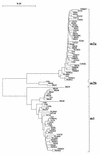Expanding allelic diversity of Helicobacter pylori vacA
- PMID: 9705399
- PMCID: PMC105169
- DOI: 10.1128/JCM.36.9.2597-2603.1998
Expanding allelic diversity of Helicobacter pylori vacA
Erratum in
- J Clin Microbiol 2000 Jun;38(6):2464
Abstract
The diversity of the gene encoding the vacuolating cytotoxin (vacA) of Helicobacter pylori was analyzed in 98 isolates obtained from different geographic locations. The studies focused on variation in the previously defined s and m regions of vacA, as determined by PCR and direct sequencing. Phylogenetic analysis revealed the existence of four distinct types of s-region alleles: aside from the previously described s1a, s1b, and s2 allelic types, a novel subtype, designated s1c, was found. Subtype s1c was observed exclusively in isolates from East Asia and appears to be the major s1 allele in that part of the world. Three different allelic forms (m1, m2a, and m2b) were detected in the m region. On the basis of sequence alignments, universal PCR primers that allow effective amplification of the s and m regions from H. pylori isolates from all over the world were defined. Amplimers were subsequently analyzed by reverse hybridization onto a line probe assay (LiPA) that allows the simultaneous and highly specific hybridization of the different vacA s- and m-region alleles and tests for the presence of the cytotoxin-associated gene (cagA). This PCR-LiPA method permits rapid analysis of the vacA and cagA status of H. pylori strains for clinical and epidemiological studies and will facilitate identification of any further variations.
Figures





Similar articles
-
Geographic distribution of vacA allelic types of Helicobacter pylori.Gastroenterology. 1999 Apr;116(4):823-30. doi: 10.1016/s0016-5085(99)70065-x. Gastroenterology. 1999. PMID: 10092304
-
Regional variation among vacA alleles of Helicobacter pylori in China.J Clin Microbiol. 2003 May;41(5):1942-5. doi: 10.1128/JCM.41.5.1942-1945.2003. J Clin Microbiol. 2003. PMID: 12734231 Free PMC article.
-
Mosaicism in vacuolating cytotoxin alleles of Helicobacter pylori. Association of specific vacA types with cytotoxin production and peptic ulceration.J Biol Chem. 1995 Jul 28;270(30):17771-7. doi: 10.1074/jbc.270.30.17771. J Biol Chem. 1995. PMID: 7629077
-
Dominant cagA/vacA genotypes and coinfection frequency of H. pylori in peptic ulcer or chronic gastritis patients in Zhejiang Province and correlations among different genotypes, coinfection and severity of the diseases.Chin Med J (Engl). 2005 Mar 20;118(6):460-7. Chin Med J (Engl). 2005. PMID: 15788126
-
Distinct variants of Helicobacter pylori cagA are associated with vacA subtypes.J Clin Microbiol. 1999 Jul;37(7):2306-11. doi: 10.1128/JCM.37.7.2306-2311.1999. J Clin Microbiol. 1999. PMID: 10364602 Free PMC article.
Cited by
-
Prevalence of Helicobacter pylori vacA, cagA and iceA genotypes and correlation with clinical outcome.Exp Ther Med. 2012 Dec;4(6):1039-1044. doi: 10.3892/etm.2012.704. Epub 2012 Sep 11. Exp Ther Med. 2012. PMID: 23226771 Free PMC article.
-
Relationship between vacA Types and Development of Gastroduodenal Diseases.Toxins (Basel). 2016 Jun 9;8(6):182. doi: 10.3390/toxins8060182. Toxins (Basel). 2016. PMID: 27294955 Free PMC article. Review.
-
Consensus and variable region PCR analysis of Helicobacter pylori 3' region of cagA gene in isolates from individuals with or without peptic ulcer.J Clin Microbiol. 2001 Feb;39(2):606-12. doi: 10.1128/JCM.39.2.606-612.2001. J Clin Microbiol. 2001. PMID: 11158115 Free PMC article.
-
Allelic Variation within Helicobacter pylori babA and babB.Infect Immun. 2001 Feb;69(2):1160-71. doi: 10.1128/IAI.69.2.1160-1171.2001. Infect Immun. 2001. PMID: 11160014 Free PMC article.
-
Helicobacter pylori vacA genotypes and cagA status and their relationship to associated diseases.World J Gastroenterol. 2000 Aug;6(4):605-607. doi: 10.3748/wjg.v6.i4.605. World J Gastroenterol. 2000. PMID: 11819658 Free PMC article. No abstract available.
References
-
- Akopyants N S, Clifton S W, Kersulyte D, Crabtree J E, Youree B E, Reece C A, Bukanov N O, Drazek E S, Roe B A, Berg D E. Analyses of the cag pathogenicity island of Helicobacter pylori. Mol Microbiol. 1998;28:37–54. - PubMed
-
- Atherton J C, Cao P, Peek R M J, Tummuru M K, Blaser M J, Cover T L. Mosaicism in vacuolating cytotoxin alleles of Helicobacter pylori. Association of specific vacA types with cytotoxin production and peptic ulceration. J Biol Chem. 1995;270:17771–17777. - PubMed
-
- Atherton J C, Peek R M J, Tham K T, Cover T L, Blaser M J. Clinical and pathological importance of heterogeneity in vacA, the vacuolating cytotoxin gene of Helicobacter pylori. Gastroenterology. 1997;112:92–99. - PubMed
Publication types
MeSH terms
Substances
Associated data
- Actions
- Actions
- Actions
- Actions
- Actions
- Actions
- Actions
- Actions
- Actions
- Actions
- Actions
- Actions
- Actions
- Actions
- Actions
- Actions
- Actions
- Actions
- Actions
- Actions
- Actions
- Actions
- Actions
- Actions
- Actions
- Actions
- Actions
- Actions
- Actions
- Actions
Grants and funding
LinkOut - more resources
Full Text Sources

